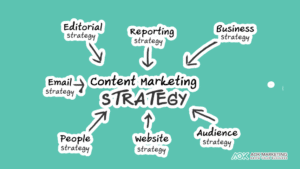A well-defined digital marketing strategy requires purposeful goals to direct efforts and measure success. But what should those goals be? This article explores the 8 essential goals you must consider when creating a strategy that resonates with audiences, drives growth, and wins in search engine rankings.
1. Build Brand Awareness
Why It Matters
Brand awareness ensures your target audience knows your brand exists—and more importantly, what it stands for. Without awareness, other goals such as traffic or leads are much harder to achieve.
How to Set It
-
Metrics: Online mentions, branded search volume, social reach.
-
Tactics: SEO for branded terms, display and social ads targeting new audiences, influencer collaborations.
Tip
Consistent visuals and messaging across all channels strengthens brand recall and trust.

2. Drive Website Traffic
Why This Goal Matters
More traffic gives you more opportunities to engage, convert, and retarget potential customers.
How to Set It
-
Metrics: Sessions, unique visitors, referrals.
-
Tactics: SEO content optimized for high-intent keywords, PPC ads, guest posts, partnerships, email campaigns with CTAs.
Tip
Diversify traffic sources to avoid over-reliance on one channel, and always mirror top-performing content across formats.
3. Generate Leads and Contacts
Why This Goal Matters
Leads are potential customers. They’re the most immediate path to revenue and scale.
How to Set It
-
Metrics: Form fills, content downloads, webinar signups, click-to-call.
-
Tactics: Gated content, high-converting landing pages, effective CTAs, lead magnets (e.g., checklists, templates).
Tip
A/B test headline copy, form fields, and CTAs to pinpoint the most effective options.
4. Increase Conversions & Sales
Why This Goal Matters
Traffic and leads are just steps—sales impact your bottom line.
How to Set It
-
Metrics: Conversion rate, cost per acquisition (CPA), average order value (AOV).
-
Tactics: Retargeting ads, email sequences, abandoned-cart recovery, social proof (testimonials, case studies).
Tip
Simplify the buying process: fewer steps, mobile-friendly pages, and clear benefits.
5. Boost Customer Retention & Loyalty
Why This Goal Matters
It’s more affordable to retain existing customers than acquire new ones—and loyal customers can become brand advocates.
How to Set It
-
Metrics: Repeat purchase rate, churn rate, customer lifetime value (CLTV).
-
Tactics: Email loyalty sequences, exclusive discounts, VIP programs, post-purchase surveys, and support.
Tip
Use personalization in your messaging—reference past purchases and recommend relevant products or content.
6. Enhance Thought Leadership & Authority Through a Digital Marketing Strategy
Why This Goal Matters
Authority positions your brand as a trusted, industry-leading voice, increasing trust and media interest.
How to Set It
-
Metrics: Backlinks, domain authority, media mentions, social shares.
-
Tactics: Publish comprehensive guides, host webinars, speak at industry events, contribute to reputable publications.
Tip
Well-researched pillar content boosts both SEO and perceived expertise.
7. Optimize Customer Experience (CX)
Why This Goal Matters
A seamless, intuitive online experience encourages visitors to stay, explore, and convert.
How to Set It
-
Metrics: Bounce rate, page load speed, time on site, user feedback scores.
-
Tactics: Performance testing, intuitive navigation, mobile-first design, live chat support, accessibilty improvements.
Tip
Regularly audit site structure and user flows—look to remove friction points like slow pages or confusing CTAs.
8. Expand Into New Channels or Markets
Why This Goal Matters
Growth often requires exploration—whether through new platforms or geographic expansion.
How to Set It
-
Metrics: New channel traffic share, international sales, engagement metrics on new platforms.
-
Tactics: Launch campaigns on emerging platforms (e.g., TikTok, LinkedIn audio), localize content, test OOH (out-of-home) digital.
Tip
Pilot campaigns before full launch to validate ROI before investing heavily.
How to Prioritize & Integrate These Goals
-
Consult Stakeholders – Align with company objectives and target personas.
-
Audit Current Performance – Evaluate existing KPIs and channel performance.
-
Balance Short-Term Wins with Long-Term Gains
-
Quick wins: PPC campaigns, email opt-ins
-
Long-term: SEO, thought leadership, CX enhancements
-
-
Allocate Resources with Purpose – Budget and team assignments should fit each goal.
-
Set SMART KPIs – For example: “Increase organic site traffic by 25% in 6 months” or “Improve email-driven revenue by 15% by Q4.”
-
Track Progress & Optimize – Regular dashboards, A/B tests, performance tracking.
Real-World Example
Case: “EcoWear,” a sustainable e-commerce brand
-
Brand Awareness: Influencer partnerships and Instagram ads raised branded search by 35%.
-
Traffic: Blog + SEO = 40% increase in sessions over 6 months.
-
Leads: Gated sustainability guides captured 5,000+ emails.
-
Sales: Retargeting helped boost purchase rate by 12%.
-
Retention: Loyalty program doubled repeat purchase rate.
-
Authority: Published packaging waste study cited by 50+ external sites.
-
CX: Page-speed optimization led to 20% drop in bounce rate.
-
New Markets: Facebook and Pinterest ads resulted in 15% international sales growth.
Conclusion
Crafting a digital marketing strategy isn’t just about picking a channel—it’s about defining measurable goals, aligning them with overall business objectives, and executing in a balanced, data-driven way. By focusing on these 8 goals—from brand awareness to market expansion—your strategy becomes robust, scalable, and primed for success in search rankings and conversions.
About The Author
Jana Legaspi
Jana Legaspi is a seasoned content creator, blogger, and PR specialist with over 5 years of experience in the multimedia field. With a sharp eye for detail and a passion for storytelling, Jana has successfully crafted engaging content across various platforms, from social media to websites and beyond. Her diverse skill set allows her to seamlessly navigate the ever-changing digital landscape, consistently delivering quality content that resonates with audiences.





